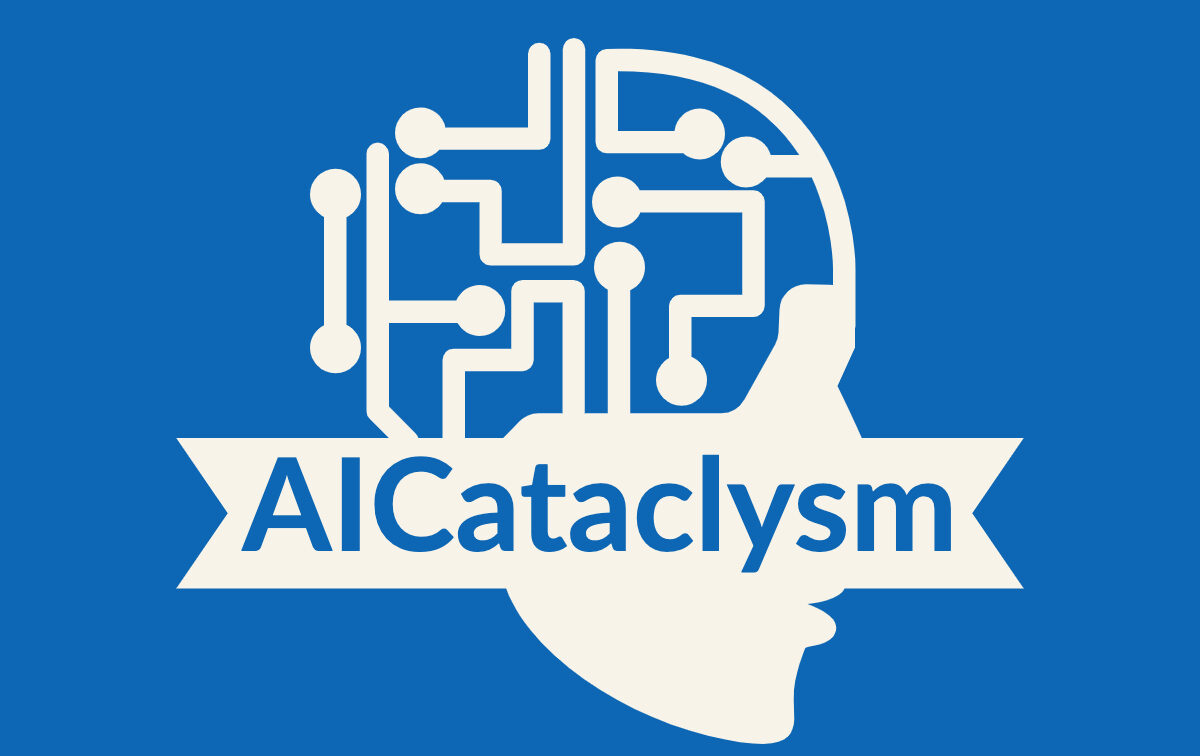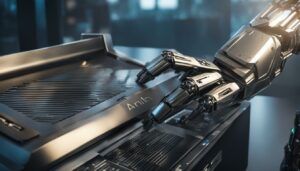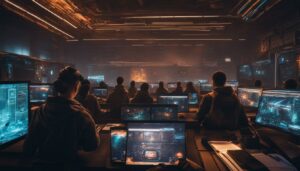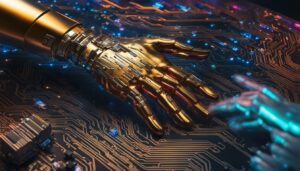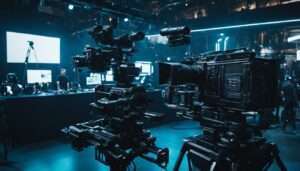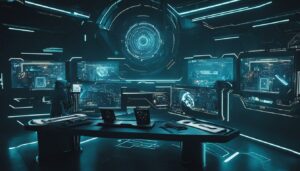Recent advancements in AI have raised questions about the potential of AI to replace 3D artists in the future. This article will analyze the role of AI in the 3D art industry, its impact on 3D artists, and the benefits and limitations of AI in this field.
Key Takeaways:
- AI has the potential to revolutionize the future of 3D art, but it is unlikely to fully replace human artists.
- Texture artists play a critical role in 3D animation by creating surface materials, textures, and shaders.
- AI has shown progress in automating certain texturing tasks, but it still lacks true creativity and struggles with organic materials.
- AI can be a powerful tool and collaborator in the creative process, enhancing human artistic vision and amplifying creativity.
- Embracing AI can lead to new possibilities, streamlined workflows, and enhanced creativity in the field of 3D art.
The Critical Role of Texture Artists in 3D Animation
In the world of 3D animation, texture artists play a critical role in bringing characters and environments to life visually. They are the maestros of surface materials, textures, and shaders, responsible for creating the intricate details that make animated scenes feel realistic and immersive.
Texture artists are skilled in painting realistic textures, developing reusable texture libraries, and creating complex shader networks. They collaborate closely with other artists and supervisors to ensure that the visual elements of an animation align with the creative vision of the project.
One of the key tasks of a texture artist is to paint textures that add depth, detail, and realism to 3D models. They use specialized software and tools to apply textures to objects, surfaces, and characters, meticulously crafting every bump, wrinkle, and imperfection. This attention to detail is what brings characters to life, making them relatable and believable to the audience.
Additionally, texture artists create reusable texture libraries that can be applied to multiple objects within a project. These libraries save time and effort by providing a range of pre-made textures that can be easily customized and applied to different elements. By leveraging texture libraries, texture artists can maintain consistency across scenes and ensure a cohesive visual style.
The work of texture artists also involves creating shader networks, which define how light interacts with different surfaces in a scene. By manipulating shader settings, texture artists can control how materials reflect, refract, and absorb light, resulting in stunning visual effects. They troubleshoot texture and shader issues, ensuring that the final rendering of an animation retains the intended look and feel.
Current Progress of AI in Texturing for 3D Animation
AI has made significant strides in the field of texturing for 3D animation, offering a range of tools and capabilities that can streamline and enhance the texturing process. From AI texture generation to neural rendering engines, these advancements have the potential to revolutionize the way texture artists work.
AI Texturing Tools
One of the key areas of progress is in AI texture generation tools. These tools can analyze existing source textures and generate realistic variations with minimal manual input. Tools like Substance Alchemist and PBR Bot utilize AI algorithms to analyze texture data and create high-quality textures that can be used in 3D animation projects. This saves time and effort for texture artists, allowing them to focus on other aspects of their work.
AI painting and synthesis tools have also emerged, allowing artists to create textures using AI-assisted techniques. These tools, such as GauGAN, employ neural networks to synthesize photorealistic textures, enabling artists to quickly generate complex textures for landscapes, objects, and more.
Additionally, procedural material filters powered by AI algorithms offer a range of options for adding complexity and realism to procedurally-generated textures. Artists can apply these filters to create intricate patterns, weathering effects, and other details that would traditionally require significant manual effort.
| AI Texturing Tools | Benefits | Limitations |
|---|---|---|
| Texture Generation | – Time-saving – Realistic variations – Automated process | – Lack of creativity – Limited control |
| AI Painting and Synthesis | – Photorealistic textures – Quick generation – AI-assisted techniques | – Difficulty with organic materials – Limited artistic control |
| Procedural Material Filters | – Complex patterns – Realistic details – Procedural generation | – Complexity in usage – Lack of customization |
While AI texturing tools offer numerous benefits, they also have their limitations. AI lacks true creativity and may produce generic or predictable textures. Artists may also find it challenging to achieve their desired look when working with organic materials, such as human skin and hair. Additionally, some tools may have limited customization options, requiring artists to find a balance between automation and manual control.
Despite these limitations, the current progress of AI in texturing for 3D animation is undeniably promising. With continued advancements and refinement, AI has the potential to revolutionize the texturing process and offer new possibilities for texture artists in the future.
Potential Benefits of AI Textures
AI texturing tools offer numerous potential benefits that can greatly enhance the 3D art industry. One of the primary advantages is faster iteration and feedback. With AI-powered texture generation, artists can quickly experiment with different options and make adjustments in real-time, allowing for more efficient production processes and shorter project timelines.
Another significant benefit is the ability to create customizable material libraries. AI can analyze a wide range of textures and generate variations that can be customized to meet specific artistic requirements. This flexibility enables artists to quickly access a vast array of textures, reducing the need for manual painting and saving time and effort.
The democratization of texturing is also a key advantage of AI. Previously, creating high-quality textures required specialized skills and expensive software. However, AI texturing tools make texturing more accessible to indie creators and small studios who may not have the resources or expertise to create intricate textures manually. This democratization fosters creativity and diversity within the industry.
| Benefits of AI Textures |
|---|
| Faster iteration and feedback |
| Customizable material libraries |
| Reduced need for manual painting |
| Democratization of texturing |
| Cost and time savings |
AI texturing tools offer numerous potential benefits that can greatly enhance the 3D art industry, including faster iteration and feedback, customizable material libraries, reduced need for manual painting, democratization of texturing, and cost and time savings.
Lastly, AI textures can result in significant cost and time savings for production budgets and schedules. With AI handling certain texturing tasks, artists can focus on other aspects of the workflow, such as concept development and finalizing artistic vision. This efficiency can lead to reduced costs and quicker turnaround times for projects.
Conclusion
The potential benefits of AI textures in the 3D art industry are substantial. Faster iteration, customizable material libraries, reduced reliance on manual painting, democratization of texturing, and cost and time savings are just a few of the advantages that AI brings to the table. By harnessing the power of AI texturing tools, artists can streamline their workflows, unlock new creative possibilities, and ultimately elevate the quality and efficiency of their work.
Current Limitations of AI in Texturing
While AI has made significant progress in automating certain aspects of texturing for 3D animation, there are still limitations to consider. One of the key limitations is the lack of true creativity in AI-generated textures. While AI algorithms can analyze and replicate existing textures, they struggle with making holistic aesthetic decisions that require artistic sensibilities and human intuition.
Another limitation is that most AI texturing tools require guidance and input from human texture artists. AI can assist in generating textures, but it still relies on human artists to provide artistic direction and make final decisions. This collaborative approach ensures that the final result aligns with the artistic vision and intent.
Furthermore, AI faces difficulties when it comes to replicating complex organic materials such as human skin and hair. These materials have intricate details and variations that are challenging for AI algorithms to capture accurately. As a result, human texture artists are still needed to create realistic and nuanced organic textures.
Hardware limitations also play a role in the use of AI in texturing. Training neural networks on large texture datasets requires specialized computing power, which may not be accessible to all artists and studios. This limitation can restrict the widespread adoption and use of AI texturing tools.
The Risk of Overusing AI Textures
Lastly, there is a risk of overusing AI textures, leading to generic and repetitive visuals. AI-generated textures, while convenient and time-saving, can lack the uniqueness and individuality that human-created textures offer. Over-reliance on AI textures may result in a homogenization of visual styles and a loss of artistic expression.
It is important to recognize and navigate these limitations when incorporating AI into the texturing process. By understanding the boundaries of AI and utilizing it in conjunction with human creativity and expertise, the full potential of AI in 3D art can be realized.
| Limitations of AI in Texturing | |
|---|---|
| Lack of true creativity in AI-generated textures | Guidance required from human artists |
| Difficulty in replicating complex organic materials | Human texture artists still needed |
| Hardware limitations for training neural networks | Specialized computing power required |
| Risk of overusing AI textures | Generic and repetitive visuals |
Evolving the Role of Texture Artists in the Age of AI
The advancement of AI technology has sparked discussions about the potential impact on the role of texture artists in the 3D art industry. As AI texturing tools continue to improve, the role of texture artists may undergo significant changes, evolving to incorporate new responsibilities and approaches.
One possible evolution is the supervision of AI systems. Texture artists can oversee and guide AI-powered tools to ensure optimal results and maintain artistic control. By combining their expertise with the capabilities of AI, artists can achieve a balance between efficiency and artistic expression.
Another avenue for the evolving texture artist is the integration of both hand-painted and AI-generated textures. While AI can automate certain texturing tasks, such as generating realistic variations, artists can still contribute their unique style and artistic touch by hand-painting textures. Combining the best of both worlds can result in visually stunning and unique outcomes.
Artist Oversight and Guidance
As AI becomes more involved in the texturing process, texture artists can shift their focus to providing artistic oversight and guidance. This involves ensuring that AI systems produce textures that align with the intended style and vision of the project. Artists can use their expertise to guide AI algorithms and algorithms, making creative decisions and ensuring the overall quality of the final product. By taking on this supervisory role, texture artists can maintain their artistic influence while harnessing the efficiency of AI technology.
| Role Evolution | Description |
|---|---|
| AI Systems Supervision | Overseeing and guiding AI-powered tools to ensure optimal results and maintain artistic control. |
| Combining Hand-painted and AI-generated Textures | Integrating both traditional hand-painted textures and AI-generated textures to achieve unique and visually stunning outcomes. |
| Focus on Style | Shifting the focus towards providing artistic oversight and guidance, ensuring that AI-generated textures align with the desired artistic style. |
| Artist Oversight and Guidance | Taking on a supervisory role, utilizing artistic expertise to guide AI algorithms and ensure the overall quality of the final textures. |
As AI continues to advance, the texture artist role will likely evolve to incorporate these new responsibilities. Rather than being replaced, texture artists will work alongside AI systems, harnessing the power of technology while maintaining their artistic vision and influence.
When Might AI Actually Replace Texture Artists?
AI’s rapid advancements have led to speculation about the possibility of AI replacing texture artists in the future. However, experts believe that complete replacement is unlikely to happen anytime soon. While AI has made significant progress in automating certain texturing tasks, it still lacks the artistic sensibilities and creativity of human texture artists. True creativity, the ability to make holistic aesthetic decisions, and the understanding of intricate organic materials like human skin and hair are skills that AI currently struggles to replicate. These limitations indicate that AI replacing texture artists is not expected within the next 10 years.
“AI has shown significant potential in automating certain aspects of texturing, but it is far from being able to fully replace human texture artists. The human touch, creativity, and artistic vision are irreplaceable in the field of 3D art.”
While AI can assist texture artists by automating repetitive tasks and generating variations, it is still necessary for human artists to provide guidance and input to achieve desired results. Texture artists bring their unique perspectives and artistic choices to the table, making their role essential in the creative process. The future of texture artists may involve overseeing and guiding AI systems, combining hand-painted and AI-generated textures, focusing on stylistic choices, and providing artistic oversight and guidance to AI systems.
In conclusion, AI is unlikely to replace texture artists in the near future. While AI has made progress in automating certain texturing tasks, it still lacks the artistic sensibilities and creativity of human artists. The collaboration between AI and human texture artists has the potential to lead to new possibilities, streamlined workflows, and enhanced creativity in the field of 3D art.
Timeline for AI Replacing Texture Artists
| Timeframe | Possibility of AI Replacing Texture Artists |
|---|---|
| Within 5 years | Unlikely |
| Within 10 years | Unlikely |
| Within 15 years | Possible, but limited |
| Beyond 15 years | Possible, but uncertain |
Note: The timeline provided is based on current advancements in AI and is subject to change as technology evolves. It is important to continually reassess the progress of AI and its impact on the field of 3D art.
Real-World Examples and Case Studies
AI has made significant strides in revolutionizing the production of 3D animation. Let’s explore some real-world examples and case studies that showcase how AI is integrated into creative workflows and its impact in the industry.
AI in The Lion King (2019)
One notable example is the use of AI in the production of The Lion King (2019). The film utilized AI-powered texture generation tools to create lifelike and immersive visuals. Through AI algorithms, artists were able to generate intricate textures and detail for the characters, environments, and landscapes, resulting in a visually stunning and realistic portrayal of the African savannah.
AI in Unreal Engine 5
Another prominent case study is the integration of AI in Unreal Engine 5, a popular game development platform. Unreal Engine 5 leverages neural rendering approaches and AI-driven algorithms to provide artists with customizable textures and variations. This advancement in AI technology allows game developers to create visually rich and diverse environments that enhance the player’s immersive experience.
AI Integration in Creative Workflows
Across the 3D animation industry, AI is increasingly being integrated into creative workflows. From assisting with tasks like texture generation and material synthesis to automating repetitive processes, AI tools are streamlining production timelines and improving efficiency. By harnessing the power of AI, artists can focus more on the artistic aspects of their work, pushing the boundaries of creativity and innovation.
| Real-World Example | AI Application | Impact |
|---|---|---|
| The Lion King (2019) | AI-powered texture generation | Lifelike visuals and immersive experience |
| Unreal Engine 5 | Neural rendering and customizable textures | Visually rich and diverse environments |
These real-world examples highlight the transformative potential of AI in 3D animation production. By utilizing AI tools and technologies, artists can unleash their creativity, enhance their workflows, and deliver awe-inspiring visuals to captivate audiences.
The Artistic World’s Reaction to AI in 3D Art
The introduction of AI in the art world has sparked a range of reactions, from enthusiasm to resistance. As a texture artist, I’ve personally witnessed the impact of AI in 3D art and have seen artists embrace AI as a powerful tool that enhances creativity and streamlines workflows. AI has the potential to revolutionize the way we create art, but it is essential to understand its role as a collaborator rather than a replacement for human artists.
AI in 3D art opens up new possibilities by providing artists with cutting-edge tools for texture generation, material customization, and procedural workflows. With AI, artists can explore a wider range of styles and aesthetics, generate complex textures more efficiently, and iterate on their ideas much faster. By leveraging AI as a tool, artists can elevate their creative output and bring their artistic visions to life in ways that were previously unimaginable.
“AI has the potential to revolutionize the way we create art, but it is essential to understand its role as a collaborator rather than a replacement for human artists.”
However, there are also valid concerns within the artistic community. Some artists resist the integration of AI due to worries about copyright infringement, loss of human artistic expression, and the potential homogenization of artistic styles. These concerns highlight the need for a balanced approach to AI in 3D art, where human artists maintain their creative autonomy, while leveraging AI as a tool for inspiration and technical assistance.
Overall, the artistic world’s reaction to AI in 3D art is diverse, reflecting the ongoing dialogue between traditional artistic practices and emerging technological advancements. As a texture artist, I believe in embracing AI as a transformative force in the creative process. By combining the unique abilities of AI with the creativity and vision of human artists, we can unlock new realms of artistic exploration and create groundbreaking works that push the boundaries of 3D art.
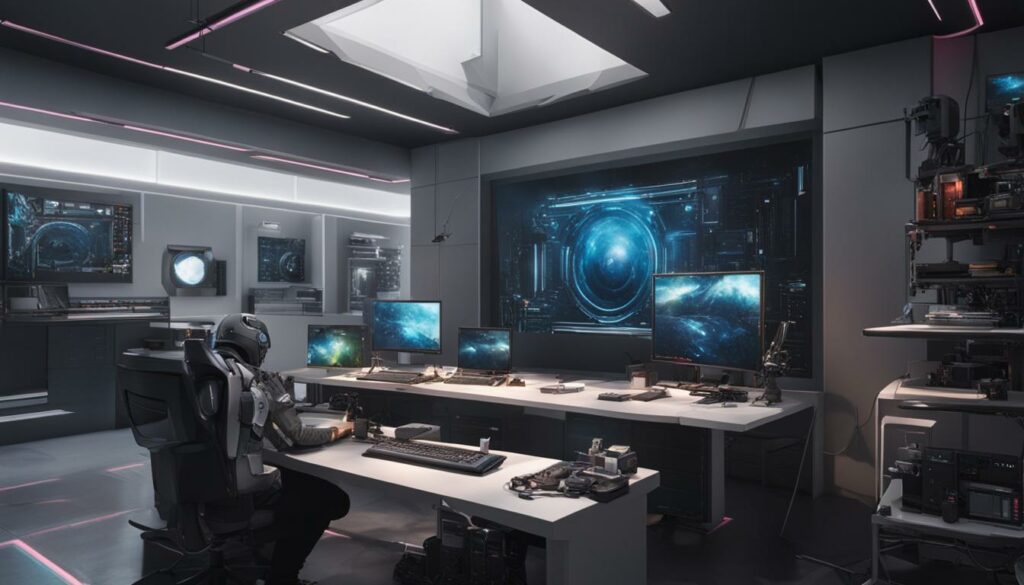
AI as a Tool, AI as a Collaborator
| Pros | Cons |
|---|---|
| Enhances creativity and productivity | Concerns about copyright infringement |
| Streamlines workflows and speeds up the iteration process | Potential loss of human artistic expression |
| Expands artistic possibilities and styles | Homogenization of artistic styles |
| Provides technical assistance and automation | Dependency on AI technology |
AI’s Potential Impact on the Future of 3D Art
Artificial Intelligence (AI) has the potential to revolutionize the future of 3D art by offering new opportunities for creative expression and streamlining workflows. In recent years, AI has made significant advancements in various areas of the creative process, including 3D modeling and virtual reality. These advancements have the potential to enhance the capabilities of artists and architects, automate certain processes, and introduce new possibilities for the field of 3D art.
One area where AI is making a significant impact is in 3D modeling. AI algorithms can analyze vast amounts of data to generate realistic and detailed 3D models, saving time and effort for artists. This technology enables artists to focus more on the artistic aspects of their work, such as composition and storytelling, while AI takes care of the technical aspects of modeling.
Furthermore, AI is also playing a crucial role in the development of virtual reality (VR) experiences. By harnessing the power of AI, VR environments can be created with greater ease and efficiency. AI algorithms can generate realistic textures and lighting effects, enhancing the immersive quality of VR experiences. This technology allows artists to create virtual worlds that were once limited by technical constraints.
| AI’s Impact on 3D Art | AI’s Role in the Creative Process |
|---|---|
| – Enhanced capabilities of artists and architects. | – Streamlining workflows and automating certain processes. |
| – Time and effort savings in 3D modeling. | – Enabling artists to focus on artistic aspects. |
| – Creation of immersive VR environments. | – Generating realistic textures and lighting effects. |
While the impact of AI on 3D art is undeniable, it is important to note that human creativity and artistic vision remain crucial in this field. AI may assist in various aspects of the creative process, but it lacks the ability to replicate the unique perspectives, emotions, and innovative thinking of human artists. Therefore, the future of 3D art is likely to involve a collaboration between human artists and AI systems, where human creativity is amplified and enhanced by AI technology.
As AI continues to evolve, it is essential for artists to embrace the potential of this transformative force in 3D art. By utilizing AI as a tool and collaborator, artists can unlock new possibilities, streamline their workflows, and push the boundaries of their creativity. The future of 3D art holds immense potential, and the combination of AI and human artistic talent can lead to exciting and innovative developments in the field.
The Role of AI in Virtual Reality
“AI algorithms can generate realistic textures and lighting effects, enhancing the immersive quality of VR experiences. This technology allows artists to create virtual worlds that were once limited by technical constraints.”
The Importance of Human Creativity
While AI can provide powerful tools and automation capabilities, human creativity and artistic vision remain crucial in the field of 3D art. The unique perspectives, emotions, and innovative thinking of human artists cannot be replicated by AI. Therefore, the future of AI in 3D art is likely to involve a collaboration between human artists and AI systems, where human creativity is amplified and enhanced by AI technology.
Human Creativity and the Future of AI in 3D Art
When it comes to the future of AI in 3D art, human creativity remains a fundamental and irreplaceable element. While AI has made significant advancements in automating certain tasks and assisting artists, it cannot replicate the depth of human emotions, unique perspectives, and innovative thinking that human artists bring to the table. AI can be a powerful tool and collaborator, but it is the role of human artists to provide the artistic vision and creative input that drive the field forward.
AI and human collaboration in the world of 3D art can lead to remarkable results. By combining the strengths of AI technology with the creative instincts of human artists, new and exciting possibilities emerge. Human artists can guide and shape AI systems, using them as valuable tools in their artistic process. Together, they can push the boundaries of what is possible and achieve outcomes that neither could accomplish alone.
While AI can streamline workflows and offer new avenues for creative exploration, it is important to recognize that AI-driven art is a product of human guidance and oversight. The role of human artists in this context is to infuse their work with originality, authenticity, and a personal touch. AI can provide suggestions and automate certain processes, but it is the human touch that adds the soul and essence to the final artistic creation.
Embracing the Collaboration
The future of AI in 3D art lies in the collaboration between human artists and AI systems. Rather than replacing human artists, AI should be seen as a tool that enhances and amplifies human creativity. By embracing this collaboration, artists can leverage the power of AI to explore new techniques, streamline their workflows, and push the boundaries of their artistic expression. Ultimately, the future of AI in 3D art is not about replacing human artists but providing them with powerful tools to expand their artistic horizons.
In conclusion, human creativity is the driving force behind AI-driven art. While AI can offer valuable assistance and automation, it is the role of human artists to infuse their work with the depth, emotion, and innovation that only they can bring. By embracing the collaboration between AI and human artists, the future of 3D art holds tremendous potential for groundbreaking creations and artistic exploration.
Conclusion: Embracing the Potential of AI in 3D Art
As I wrap up this exploration of AI in the world of 3D art, it is clear that AI has the potential to be a transformative force in the industry. While it may not replace human artists, AI can revolutionize the creative process by becoming a powerful tool and collaborator.
Embracing AI in 3D art opens up a world of new possibilities. With AI as a partner, artists can streamline their workflows, save time and costs, and enhance their creativity. AI’s capabilities in automating certain processes and generating realistic textures can elevate the quality and efficiency of 3D art production.
However, it is important to remember that AI is just a tool. The true power of 3D art lies in the hands of human artists who bring unique perspectives, emotions, and innovative thinking to their creations. AI is at its best when it amplifies and enhances human creativity, working hand in hand with artists to push the boundaries of what is possible.
So, let us embrace the potential of AI in 3D art. Together, we can shape the future of the industry in exciting and innovative ways, where AI is not a replacement, but a valuable asset that empowers artists and unlocks new levels of imagination and artistic expression.
FAQ
Will AI replace 3D artists?
AI has made progress in automating certain tasks in 3D art but lacks the artistic sensibilities and creativity of human artists. Total replacement would require significant technological advancements not expected within the next 10 years.
What is the role of texture artists in 3D animation?
Texture artists create surface materials, textures, and shaders that bring animated characters and environments to life visually. They are responsible for painting realistic textures, developing reusable texture libraries, creating shader networks, and troubleshooting textures.
How is AI being used in texturing for 3D animation?
AI texture generation tools analyze source textures to generate realistic variations, neural rendering engines allow customizable textures via AI-generated parameter tweaks, and AI algorithms can synthesize photorealistic landscape textures.
What are the potential benefits of AI textures?
AI textures can offer faster iteration and feedback, customizable material libraries, reduced need for manual painting, democratization of texturing for indie creators and small studios, and cost and time savings in production budgets and schedules.
What are the limitations of AI in texturing?
AI lacks true creativity and struggles with holistic aesthetic decisions. It requires guidance from human artists and faces difficulty replicating complex organic materials. Training neural networks on large texture datasets requires specialized computing power, and overuse of AI textures can result in generic visuals.
How might the role of texture artists evolve with AI?
Texture artists may transition into overseeing and guiding AI systems, combining hand-painted and AI-generated textures, focusing more on stylistic choices, and providing artistic oversight and guidance to AI systems.
When might AI actually replace texture artists?
AI is unlikely to fully replace texture artists in the near future. Significant technological advancements would be needed, which are not expected within the next 10 years.
What are some real-world examples of AI in 3D animation production?
The Lion King (2019) used AI-powered texture generation tools, and Unreal Engine 5 implemented neural rendering approaches for customizable textures and variations.
How is the artistic world reacting to AI in 3D art?
Some artists embrace AI as a tool that enhances creativity and streamlines workflows, while others have concerns about copyright infringement and the loss of human artistic expression.
What is the potential impact of AI on the future of 3D art?
AI has the potential to revolutionize 3D art by offering new opportunities for creative expression, streamlining workflows, and enhancing the capabilities of artists. It is expected to shape the future of 3D modeling and virtual reality.
What is the role of human creativity in the future of AI in 3D art?
Human creativity and artistic vision remain crucial in 3D art. AI lacks the ability to replicate human emotions, unique perspectives, and innovative thinking. The future is likely to involve a collaboration between human artists and AI systems, where human creativity is amplified and enhanced by AI technology.
